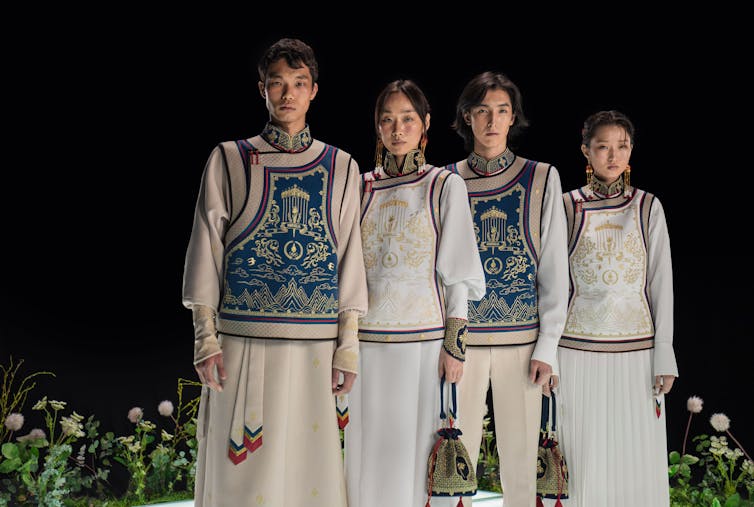Mongolia’s uniform from Michel&Amazonka.Treena Clark, University of Technology Sydney
Fashion is many things. It is practical, it is communicative, it is commercial, and it is competitive.
Looking towards the fashion of Paris 2024, some countries have multiple uniforms for the opening and closing ceremonies, podiums, media and sporting events. Some countries tell subtle or extravagant stories of their nations. The Parisian style of the host city inspires some.
Some countries want to use the latest technology to produce sustainable fabrics or recycled materials. Some countries have used designers and brands to fashion their formal uniforms.
Their commonality is they represent their country and communicate their national presence and essence.
My top five opening and closing ceremony uniforms have been considered. The countries with notable fashion brands are not favoured; my selections are based on the design’s story, meaning and overall aesthetic. These top five evoke a creative expression of national pride that resonates with my lens and preference of fashion and style.
Haiti
The Haitian opening ceremony uniform, fashioned by Haitian-Italian designer Stella Jean, represents and showcases Haiti’s beauty, strength and craft.
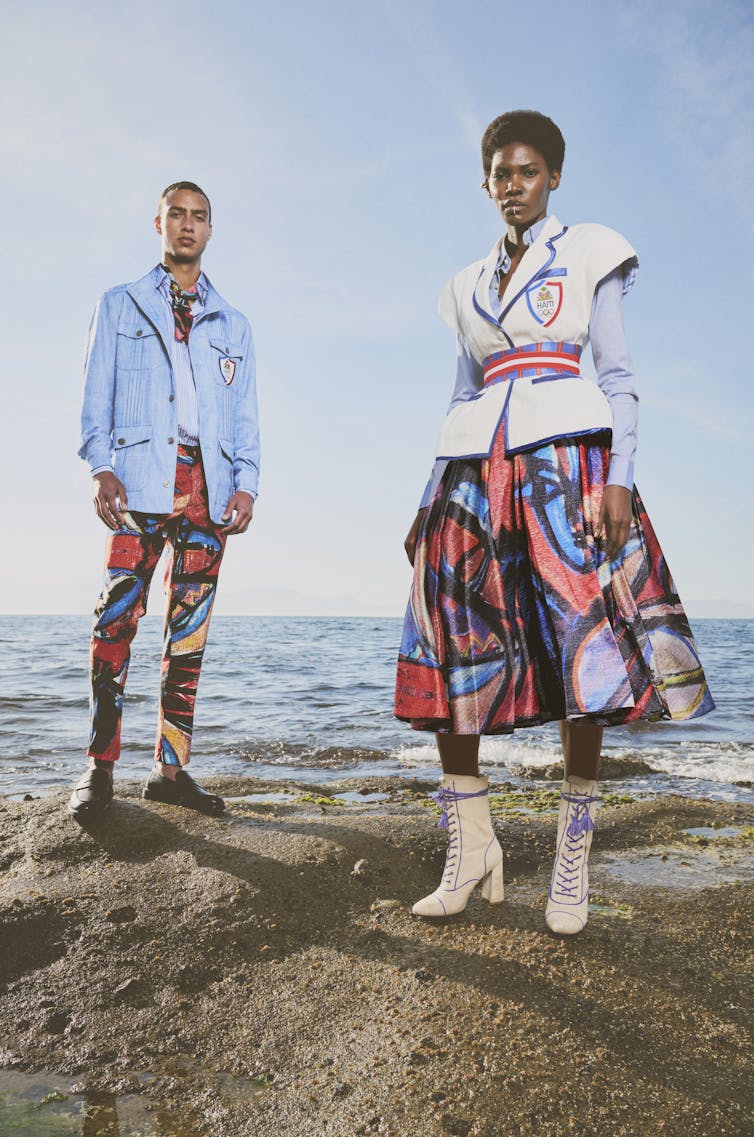 The Haitian Opening Ceremony uniform showcases Haiti’s beauty, strength and craft. Stella Jean
The Haitian Opening Ceremony uniform showcases Haiti’s beauty, strength and craft. Stella Jean
Included are the work of the Haitian painter Philippe Dodard in the women’s full-A-line skirt and the men’s pants and scarf. Pairing brilliantly with the art are the other layers of blue and white.
The women are styled in Haitian woven chambray shirts, representing the Haitian tradition of chambray production. Recycled fabric is the basis of the women’s short-sleeved white blazer, which features the Haitian Olympic emblem.
The men’s blue jacket is inspired by Haitian Guayabera shirts, both significant for the designer and a common Haitian garment. This jacket features the Haitian Olympic emblem and underneath a blue-striped shirt.
Mongolia
Mongolia’s opening and closing ceremony uniforms were crafted by the three-sister fashion label Michel&Amazonka. Each uniform, which averaged 20 hours to make, incorporates multiple cultural and Olympic-themed motifs.
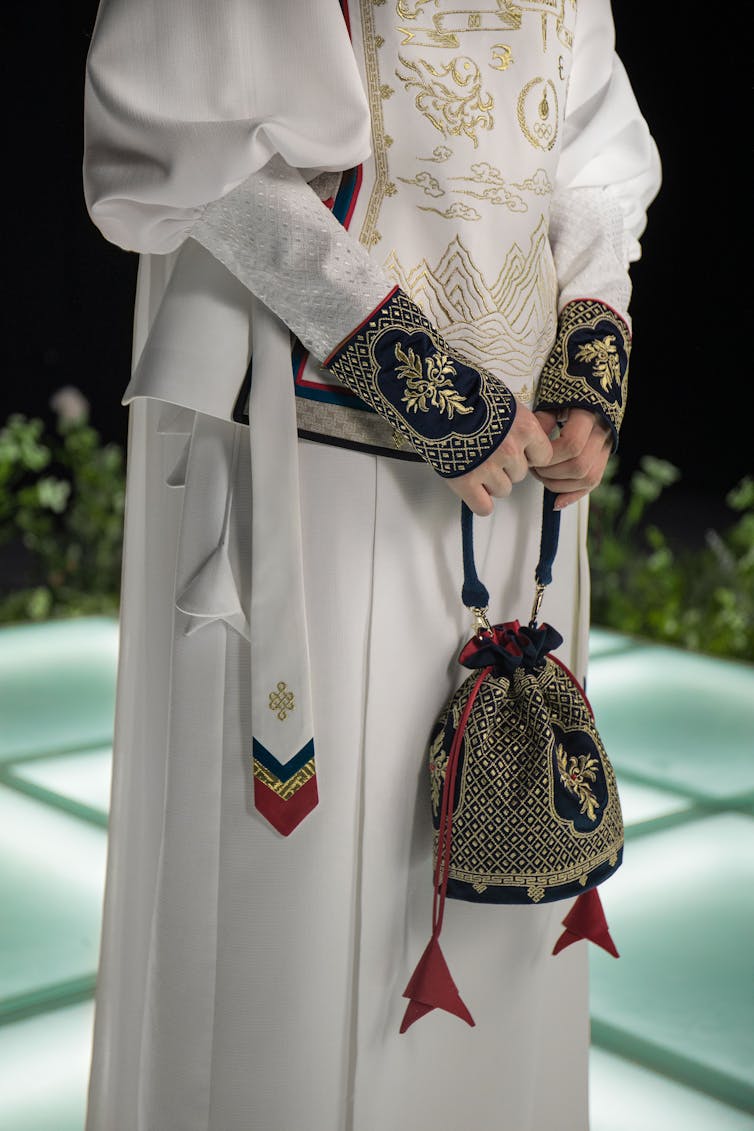 Mongolia’s uniform, from Michel&Amazonka, features intricate stitched details. Michel&Amazonka
Mongolia’s uniform, from Michel&Amazonka, features intricate stitched details. Michel&Amazonka
These intricate details include the emblem of Mongolia, the “Soyombo”; Parisian and Olympic motifs, such as the Olympic torch and rings; and mountain and cloud landscapes.
Four different opening and closing ceremony uniforms were designed for the male and female flag bearers and athletes. The flag bearers wear a traditional-inspired caftan and a belt; the athletes in pants and skirt.
All four looks showcase embroidered vests, with the men sporting blue and the women white. The vest, front and centre, announces “Go Mongolia Team”.
Canada
Canada’s lululemon-crafted uniforms were designed after consultation with 19 Olympic and Paralympic athletes across 14 diverse sports.
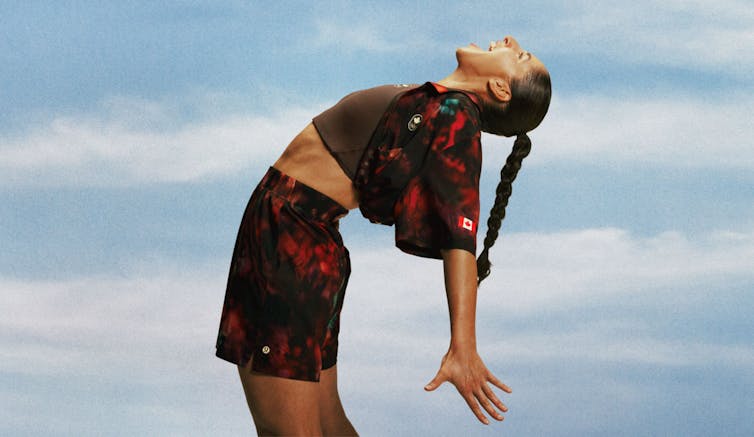 Canada’s closing ceremony uniform features Saddle Cree artist Mason Mashon’s print inspired by the northern lights. Team Canada x lululemon
Canada’s closing ceremony uniform features Saddle Cree artist Mason Mashon’s print inspired by the northern lights. Team Canada x lululemon
National pride was identified as a key priority and is significantly present in the uniforms. The other priorities were practicality, flexibility and comfort.
In the opening ceremony uniform, the brand custom-designed a print representing Canadian art, design and environment.
The equistite closing ceremony uniform features First Nations (Saddle Cree) artist Mason Mashon’s print inspired by the northern lights.
Each uniform has been crafted for comfort, including a packable rain poncho, a bomber jacket with interior straps to act as a makeshift backpack and water-resistant shirts.
Ireland
Designer Laura Weber’s creation of the Irish Opening Ceremony outfits and Closing Ceremony jackets is heavy with symbolism and sustainability.
Based in New York, the designer created the uniform for the athletes to feel their best, be comfortable in the fabrics, and celebrate their Irish culture.
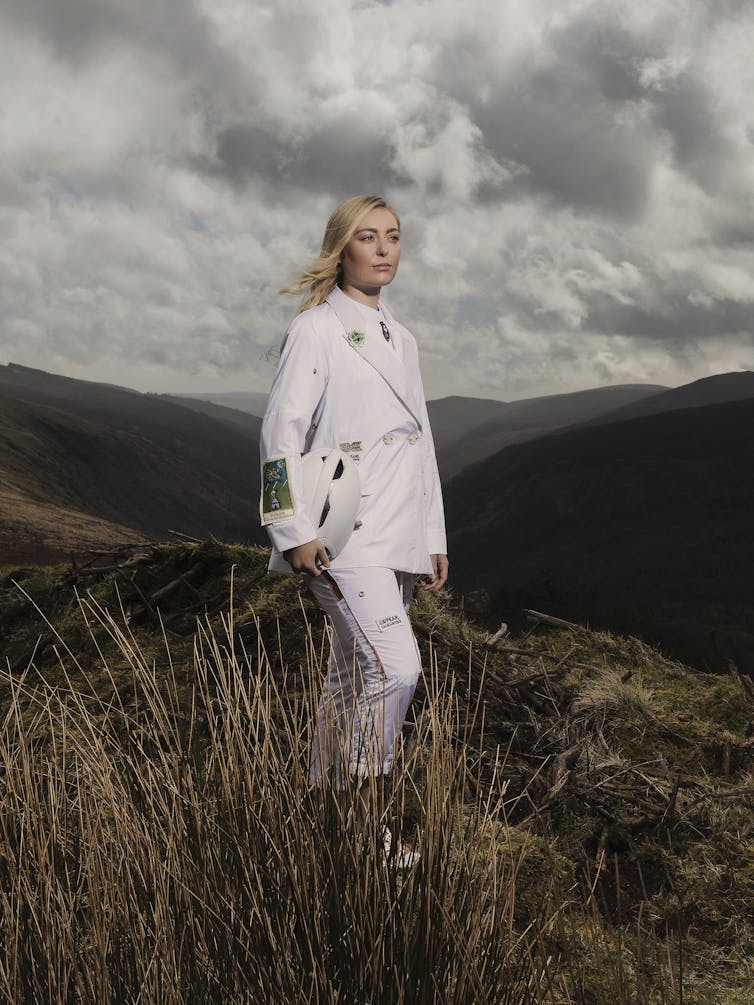 The Irish opening and closing ceremony jacket is heavy with symbolism and sustainability. Laura Weber
The Irish opening and closing ceremony jacket is heavy with symbolism and sustainability. Laura Weber
The sustainable fabric, made from recycled t-shirts and PET bottles (ECO-Hybrid taffeta), pulls moisture from the skin.
Deciding against a prominent green, the aesthetic of the uniform is a crisp white with delicate embroidery featured throughout.
The embroidery includes the Irish flag in the pant piping, hand-made shamrock brooches on the jacket lapel, hand-tufted letters spelling Ireland, and custom, individual patches representing the county emblem of each athlete.
Chinese Taipei/Taiwan
The ceremonial uniform of Taiwan, refered to by the International Olympic Committee as Chinese Taipei, represents eco-friendly materials and cultural heritage. Designed by the founder of Just In XX, Justin Chou, the stretchy and textured material represents Taiwan’s oceans, cities and mountains.
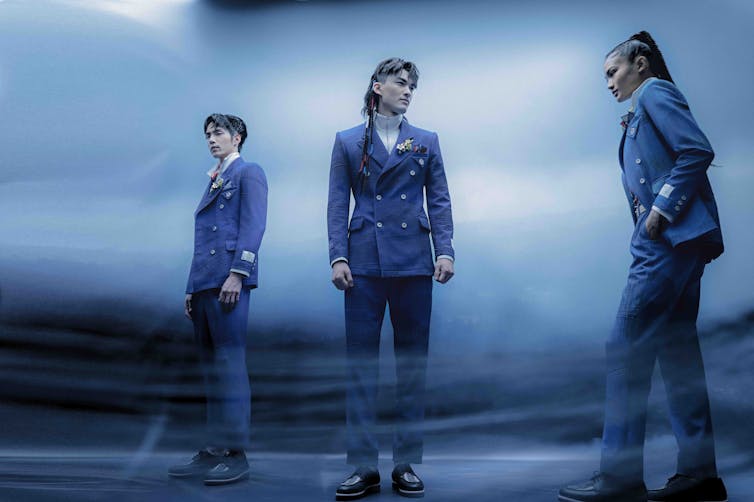 The stretchy and textured material in these uniforms from Justin Chou represents Taiwan’s oceans, cities and mountains. Just In XX
The stretchy and textured material in these uniforms from Justin Chou represents Taiwan’s oceans, cities and mountains. Just In XX
The outfits are made from materials that cool down the body when in contact with water or sweat.
Collaborations with artisan Yen Yu-Ying produced shoe tops made from banana silk woven leather. Lin Pei-ying crafted handmade plum blossom, Taiwan’s national flower, and rapeseed flowers to adorn the coat.
Abstract artist Lin Guo-Qing created the shirt and scarf print. Designed in red, white, and blue team colours, the repeated text in a crosshatch pattern reads Chinese Taipei and, when reversed, Jiayou, an expression of encouragement.
Looking forward to the ceremonies
These uniforms are for the athletes to perform their best, be proud of their national outfits and feel they genuinely represent them.
All the uniforms are captivating, whether simple, elegant, innovative, practical, unique or futuristic.
I am drawn to the design processes and stories of these five countries’ uniforms. Translating a country’s design through sporting fashions is a considerable challenge – and one these countries have risen to.![]()
Treena Clark, Chancellor’s Indigenous Research Fellow, Faculty of Design, Architecture and Building, University of Technology Sydney
This article is republished from The Conversation under a Creative Commons license. Read the original article.
